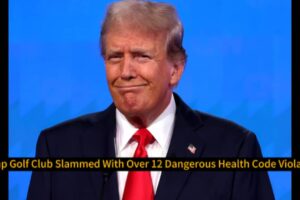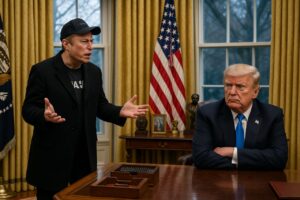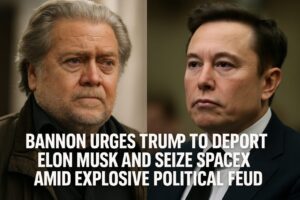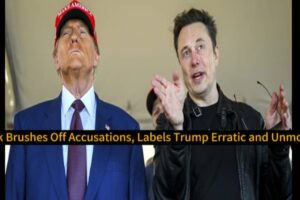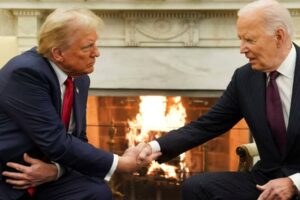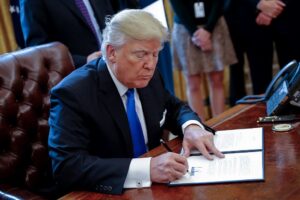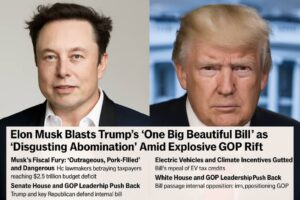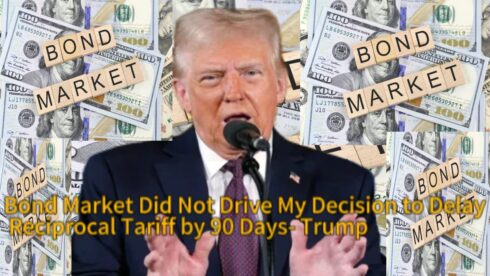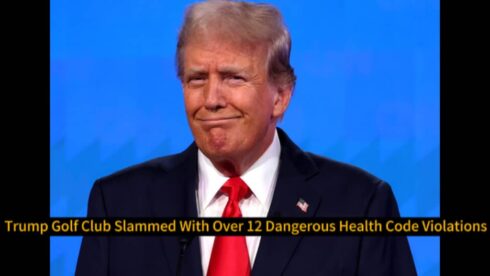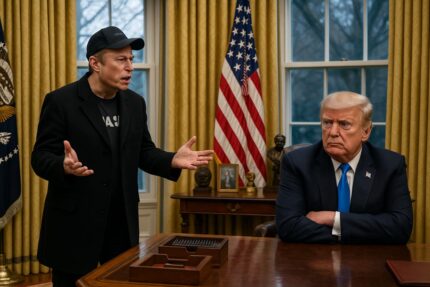President Donald Trump has vehemently denied that the bond market played any role in his decision to delay reciprocal tariffs on Chinese goods for an additional 90 days. The tariff pause, initially agreed upon during trade talks between the U.S. and China, raised eyebrows in financial circles, with many speculating that market conditions, particularly the bond market’s recent fluctuations, may have influenced the timing. However, Trump has rejected such claims, asserting that the decision was based on strategic negotiation efforts rather than market pressures. The 90-day window, set to end in mid-2025, is expected to provide both countries ample time to negotiate the terms of their trade deal.
As bond yields have been a focal point of discussions about economic stability, some market analysts had theorized that an impending inversion of the U.S. Treasury yield curve—a common indicator of a potential recession—could have motivated Trump to extend the tariff delay. Despite these assumptions, the president emphasized his confidence in the strength of the U.S. economy and denied that bond market signals had any sway over the postponement. His comments have sparked a debate over whether the delay was purely tactical or a response to mounting financial pressures, especially in the wake of global economic uncertainties.
The Bond Market’s Role in Economic Decision-Making
The bond market has long been a key barometer for the health of national economies. A significant inversion of the yield curve in the U.S. bond market—where short-term interest rates surpass long-term rates—has historically been viewed as a potential warning sign of a recession. With the U.S. bond market undergoing subtle shifts, experts have been quick to link Trump’s tariff decision to these developments. Historically, policymakers have adjusted trade and economic strategies based on bond market signals, fearing that a slowing economy could be exacerbated by trade wars.
However, President Trump has consistently dismissed concerns about recession fears, asserting that the U.S. economy remains robust and that the administration’s pro-business policies, such as tax cuts and deregulation, are driving growth. Critics argue that Trump’s stance could be shortsighted, potentially overlooking the broader economic impacts of global trade imbalances. Still, Trump’s assurance that the tariff delay was not influenced by bond market trends suggests a deliberate attempt to maintain stability in both the financial and political arenas, asserting that his decisions are driven by long-term strategic goals rather than short-term market fluctuations.
The Timing of Tariff Delays and Market Reactions
When the U.S. and China agreed to postpone reciprocal tariffs for 90 days, it was seen as a potential breakthrough in their ongoing trade dispute. Financial markets reacted positively, with major stock indices experiencing a rally in the wake of the announcement. However, the bond market’s response was more measured, with investors carefully scrutinizing any signs of weakness in the global economy. Analysts believed that the tariff pause might alleviate some of the pressure on the bond market, especially as it relates to concerns about a possible slowdown in international trade.
Despite the optimistic tone in financial markets, critics have noted that the decision could ultimately have a limited impact on the broader economic outlook. The tariff dispute has been a long-standing issue, and while the 90-day extension provides an opportunity for diplomatic negotiations, the underlying trade tensions between the U.S. and China remain unresolved. The real question is whether this temporary tariff reprieve is a genuine attempt at compromise or a political maneuver designed to buy time as both countries recalibrate their economic strategies. Trump’s dismissal of bond market influence only adds fuel to the fire of speculation, leaving analysts to wonder if other factors—such as electoral considerations—may have played a role in the timing of this delay.
Global Economic Implications of the Delay
The decision to extend the tariff delay is being closely watched by global economic leaders, particularly those in Europe and Asia. For many countries, the U.S.-China trade war has been a destabilizing force, causing ripple effects in global supply chains and investment flows. In the context of global trade dynamics, the Trump administration’s move to delay tariffs could signal a willingness to engage in more measured negotiations with China. However, this optimism is tempered by the reality that many countries are still caught in the crossfire of U.S.-China tensions, with tariffs on Chinese goods affecting numerous industries worldwide.
Global markets, particularly in emerging economies, have been heavily impacted by the tariff dispute, which has disrupted trade routes and led to shifts in manufacturing strategies. As the world’s largest economies attempt to recalibrate their trade relationships, the U.S.-China tariff war serves as a cautionary tale for smaller economies reliant on global trade flows. The question remains whether this 90-day delay will lead to substantial progress in negotiations or if it is merely a temporary band-aid for a wound that may take longer to heal.
Trump’s Trade War Strategy: Is It Working?
President Trump’s approach to trade negotiations has often been described as unconventional, yet it has undeniably made a lasting impact on U.S. foreign policy. By wielding tariffs as a strategic weapon, Trump has sought to force China to adhere to more favorable trade terms for the U.S. In the early stages of his presidency, the U.S. imposed significant tariffs on Chinese goods in an effort to reduce the trade deficit, a key issue that Trump promised to address during his campaign. While the results of these efforts are still debated, the tariff delay represents a moment of reflection in his administration’s trade strategy.
Some analysts believe that the delay could be a sign that Trump is adjusting his approach in light of the complex economic realities of global trade. By postponing the implementation of further tariffs, Trump may be attempting to avoid alienating key allies and minimize the risk of economic fallout ahead of the 2025 elections. However, others argue that this temporary truce does little to address the underlying issues of intellectual property theft, market access, and trade imbalances that continue to plague U.S.-China relations. Whether this delay signifies a genuine shift in strategy or a tactical move to gain leverage in upcoming talks remains to be seen.
Political Ramifications of the Tariff Delay Decision
The decision to delay reciprocal tariffs for an additional 90 days has significant political ramifications, both domestically and internationally. As Trump heads into an election year, his handling of economic issues, including trade, will be a key talking point in the 2025 race. While the tariff delay may be seen as a diplomatic win, it could also be interpreted as a sign of weakness in his negotiation tactics. Political opponents have argued that Trump’s approach to trade has been erratic, leading to a lack of long-term clarity for businesses and investors alike.
Internationally, the U.S. move to delay tariffs could be viewed as a signal to other trading partners that the Trump administration is open to flexibility in its trade policies. This could have wider implications for the global trading system, potentially paving the way for renewed negotiations with countries such as the European Union and Japan. However, this delay also leaves room for speculation about future policy shifts, especially as the global economy continues to face uncertainties related to inflation, supply chain disruptions, and geopolitical instability. How Trump navigates these challenges in the coming months will likely play a significant role in shaping both his political legacy and the future of U.S. trade relations.


